Hack14.Make an Articulating PSP Stand
Hack 14. Make an Articulating PSP Stand
Take an old desk lamp and turn it into an adjustable stand, complete with PSP charging capabilities. When you're watching a UMD movie on your PSP, don't you just hate having to carefully balance your PSP in your hands without accidentally hitting either the L or R trigger? Me too. So I decided to design and build a PSP stand to hold my PSP in place while I sit comfortably at my desk. If you like the sound of this, but you want something a little more portable, check out "PSP Hands Free" [Hack #18]. Figure 2-17. Two Altoids tins bolted together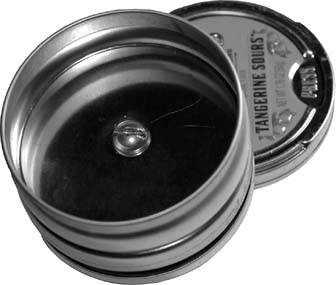 2.4.1. Things You'll NeedSeveral of the items on this list can easily be replaced with something else. This is the list of things I used:
If you opt for the cardboard mount design:
If you opt for the metal mount design:
2.4.2. Disassemble the LampAfter you have all the essentials together, it's time to start taking apart the lamp. Make sure the lamp is unplugged before you go any further. The head of the lamp (see Figure 2-18) is attached to the lamp's arm by two screws and two nuts. With the bulb removed, simply place your finger on top of one of the nuts and begin unscrewing the corresponding screw with your Phillips head screwdriver. These aren't on too tight, so the pressure from your finger should be enough to hold the nut in place as you unscrew the screw. Remove both screws. Once you do, put the screws, nuts, and washers to the side, because you'll need them later. Figure 2-18. The lamp head needs to be removed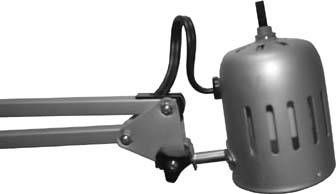 The only thing still holding the lamp head to the arm of the lamp is the electrical cord. Make sure the lamp is unplugged, then take your sharp knife or a pair of sharp scissors and cut this wire. For both the unscrewing and the cutting, I used my Swiss Army knife (see Figure 2-19). Once I cut the cord, I tossed the lamp head aside, and I was able to rather easily pull the cord free from the top part of the lamp arm. Unfortunately, the cord wasn't pulling free from the bottom part of the arm, so I had to remove this section, starting with the connection at the middle joint (see Figure 2-20). This section, just like the lamp head, is attached by a long screw and a nut. Apply pressure to the nut with a finger and remove the screw. A slight tug will pull this outer rung of the arm loose from the middle joint. Once it is free, you can pull loose the black plastic plug that was holding the power cord firmly in place. Detach the lower part of this outer rung from the base of the lamp in the same fashion, and remove its black plastic plug as well. Figure 2-19. Now that the lamp head has been unscrewed, I just need to cut the lamp's cord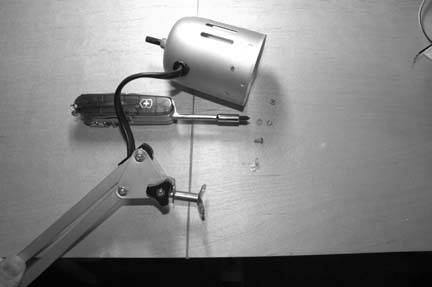 Figure 2-20. Disconnecting this section makes the plastic plug removable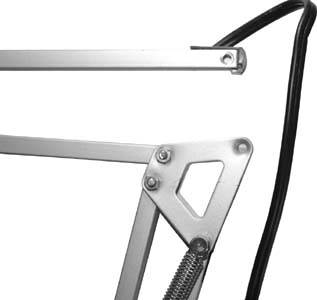 If the black plugs aren't coming free easily, use something such as a flat head screwdriver to apply steady pressure from beneath the plug (see Figure 2-21). Figure 2-21. Applying slow and steady pressure upward should free the plug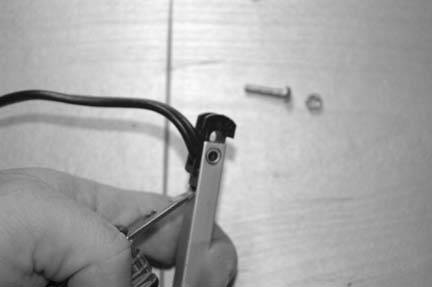 Once you have removed the plug from both ends of this piece, the cord should pull free easily. Once it is free, it is time to run the PSP's AC adapter cord up this same tube. 2.4.3. Add the PSP Adapter to the StandCompared to the power cord that was running through the arm piece, there is ample room in the tube for the PSP adapter cord to fit. The L-shaped plug at the end of the cord won't fit (see Figure 2-22), so you're going to have to cut it off several inches from the plug, run the cord through the entire length of the adjustable arm, and then re-splice the plug onto the cord. Make sure you give at least a good three inches from the plug, verify that it's not plugged into the wall, and cut straight through the cord. Figure 2-22. The PSP adapter plug won't fit in the shaft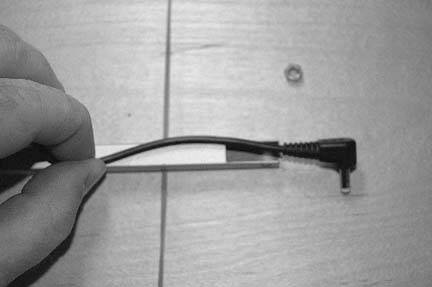 I threaded the cord through the black plastic plug, then through the bottom part of the arm piece that I had removed (see Figure 2-23), pulling it through the top of the arm piece and threading it through the second black plastic plug. I then slid the plugs back into place and reattached the arm piece to the rest of the arm. Once I reattached the arm piece, I ran the wire through the top section of the arm piece. It should go rather smoothly up the entire length of the shaft and then catch on the lip of the plastic plug at the far end. No need to disassemble this joint this time, as you can easily stick the pointed, sharp end of your knife in the hole and lift the cord slightly up as you push the cord from the other end of the shaft. This should make the cord tip pop through on the top. Pull the cord all the way through, but leave a little bit of give around the middle joint. Use duct tape to tape the power brick to the outside of the base of the arm to hold it securely in place (see Figures 2-24 and 2-25). After threading the cord through the entire length of the arm and securing the power brick to the base of the arm with duct tape, it is time to reattach the power plug to the other end of the cord. To do this, take the plug and a sharp knife and carefully cut a slit down 1 inch from the place where the cord was severed. After making this incision, pull back the cord's plastic sheath (see Figure 2-26). Figure 2-23. Threading the PSP adapter cord through the plastic plug and then through the arm piece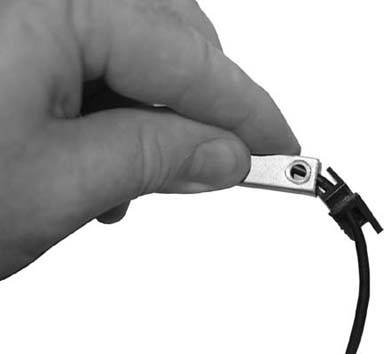 Figure 2-24. Make sure that the wire is pulled far enough so that the power brick rests close to flush with the bottom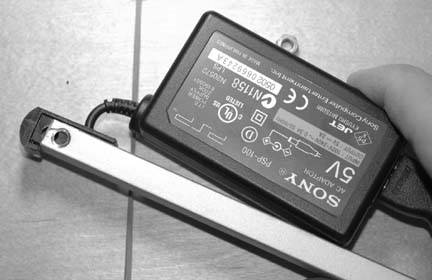 Once you pull back the black plastic, you will find a bundle of copper wires wrapped around another white wire. I didn't use wire strippers here, because I wanted to make sure I didn't lose any of the copper wrapped around the inner wire. Unwrap this copper from around the inner wire and twist it together into one wire shooting off in the same direction as the black sheath you pulled back. If you don't think you have quite enough wire to make a good splice with the cord, pull back some more of the black sheath, pull down more wire, and twist it together. Figure 2-25. After reassembling the arm, I duct taped the power brick to the outside shaft of the base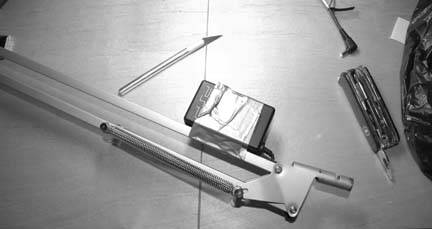 Figure 2-26. The PSP adapter's coaxial cord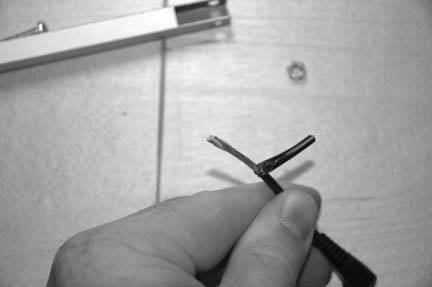 Take the knife and carefully make a similar incision on the white inner wire, but make sure to leave distance between this incision and the bundled copper wire that was wrapped around the white wire. You don't want these two groupings of copper touching, since it would cause a short circuit. At the six volts coming down this part of the wire, it wouldn't be too dangerous, but better safe than sorry. Peel back the white plastic and twist the copper wires inside this white sheath together (see Figure 2-27). Figure 2-27. Both groups of wires with enough separation where there is no risk of them touching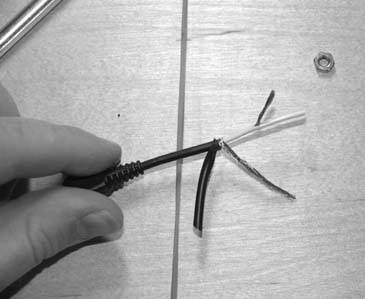 Duplicate these steps with the end of the cord that is coming out of the arm piece of the former lamp. Once both the cord and the plug are properly prepared, twist the copper wires from the outer section of each together, and the copper wires from the inner white wires of each together, as in Figure 2-28. Everything should work fine at this point, but those two differently charged bits of copper are still exposed and could hit each other and cause some sparks, so you need to grab some electrical tape and seal everything up nicely before proceeding to test your handiwork. Because the two pieces of black sheath that are jutting out from the line originally held both the white and the black sections of wire, they are loose enough to wrap around one of the wire bundles. I wrapped them around and then wrapped electrical tape around this section (Figure 2-29). Figure 2-28. Reattaching white to white and black to black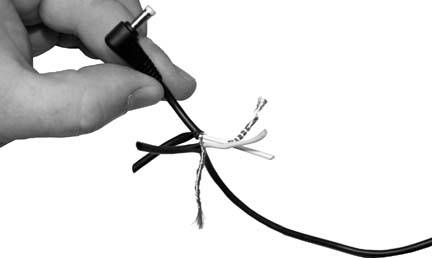 Figure 2-29. One bundle of wires taped; one to go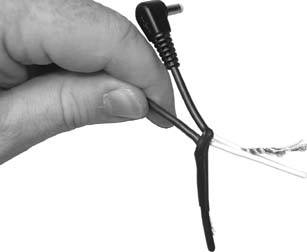 The white plastic won't wrap as nicely around the remaining bundle as the black plastic did around the other, but try to get them to and then tape these wires together (Figure 2-30). Everything is taped off nicely, but the plug is pointing in the wrong direction and there's still a little bit of the outer copper exposed right in the middle intersection of our splice job. To make this look more like a regular cord, I taped the long part that had been the bundle of outer wires to the cord side of the splice, and the shorter part that had been the bundle of inner wires to the plug side of the splice. I then wrapped a fresh layer of electrical tape down the entire length of the splice for good measure (see Figures 2-31 and 2-32). Figure 2-30. Both bundles of wires taped separately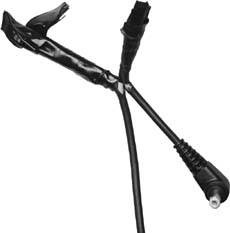 Figure 2-31. Taping the outer wire bundle down toward the cord end of the splice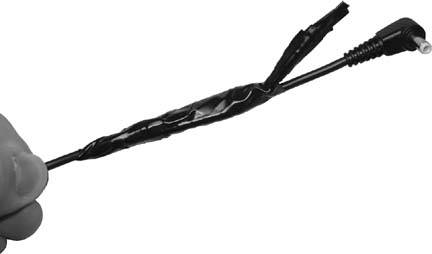 After the splice is completed, it's time to test the line. I plugged the PSP adapter into the outlet and the PSP and was met with the kind orange light of a successful charge. Now, to finish the stand. Figure 2-32. The completed splice 2.4.4. Mount the PSPAfter completing the combination of the arm and the PSP power adapter, it's time to build a mount to hold the PSP on the end of the arm. I went through two iterations of this: first, the cardboard version, or, as I like to call it, the "Lazy Mount Deluxe," and second, the metal version, or, as I like to call it, "What I Should Have Done in the First Place." I'll take you through both. 2.4.4.1. Mount Version 1.0: cardboard.For Version 1.0 of the stand, I chose to go a little bit low-tech. Since I'd already built a cardboard case for my PSP [Hack #12], I decided to devise some simple way to attach this case to the end of the arm. I still had some rather rigid pieces of cardboard lying around from that hack, so I took one thin strip of rigid cardboard and attached it to the end of the arm using the screws and nuts that originally held the head of the lamp in place (Figure 2-33). After attaching this rigid piece of cardboard to the end of the arm, all I had to do was place the PSP inside the cardboard case between the arm and this piece of cardboard, then carefully wrap the large rubber bands around either side of the case and this piece of cardboard. If you go this route, simply plug the PSP power cord into the bottom-right corner of the case, adjust the arm for optimum viewing, and sit back and enjoy a UMD movie of your choosing (Figures 2-34 and 2-35). Figure 2-33. Back view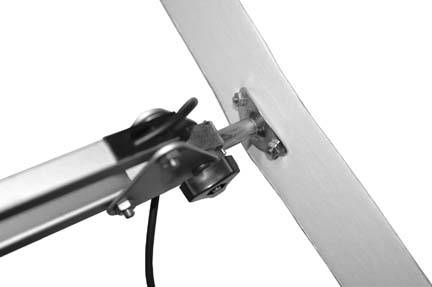 Figure 2-34. Plugging in the power cord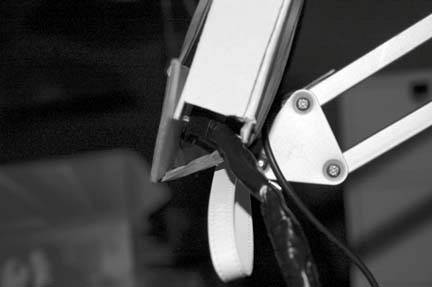 Figure 2-35. Arm extended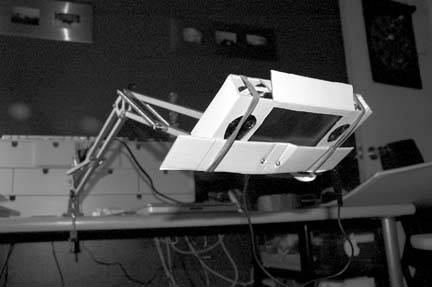 If I were simply improving upon the current design, I would build an entirely new cardboard case for the PSP, designed specifically to be permanently attached to the end of this stand with a slot at the top for removing and replacing the PSP. Ideally, there would be some sort of shade or tent to block reflections from ambient light and to give it more of a theater feeling. However, both the existing cardboard mount and the imagined one struck me as unsatisfactory, so I went back to the drawing board and came up with a much more functional and stylish mount for the PSP. 2.4.4.2. Mount Version 2.0: metal.After ripping off the cardboard mount, I took the same bolts and nuts that originally held the head of the lamp in place and attached one 2-inch bracket to each bolt (Figure 2-36). After you have attached these two brackets, you will create a metal "claw" of sorts, by using two of the #8 bolts, nuts, and washers to attach two of the 2-inch corner brackets to either end of these two flat brackets (so, a total of four 2-inch corner brackets attached). Then, on the outermost holes of the claw, attach the rubber screw bumpers with the remaining bolts and nuts. The finished product should look like Figure 2-37. The PSP slides in through the side and is held nicely in place by the grey bumpers (see Figure 2-38). Figure 2-36. Attaching the 2-inch brackets to the arm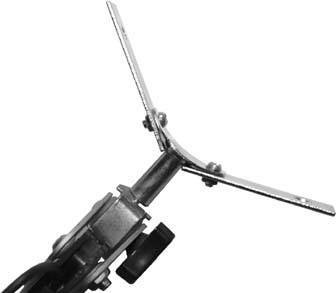 Figure 2-37. The finished "claw" mount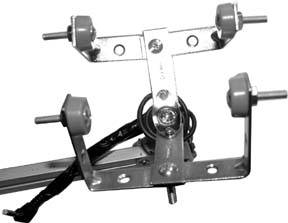 Figure 2-38. PSP in the stand; even facing down, the PSP is held securely in place by the bumpers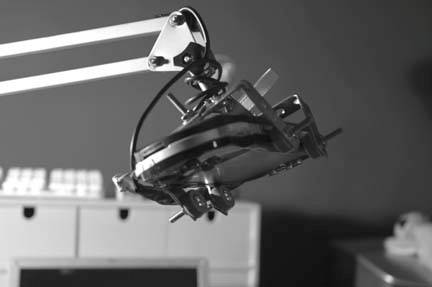 2.4.5. Hacking the HackThe actual mount for the PSP in this PSP stand is the weak point in my design and the area that could see the most improvement. Ideally, I'd like to have a mount that didn't actually surround the PSP. This would bring to the forefront the beauty of the PSP. The stand would make the PSP appear as if it were magically floating in the air. Unfortunately, such a design would entail actual modifications to the PSP. If I didn't mind screwing some holes in the back of my PSP, I would have removed the plastic casing over the UMD tray (using as much information as I could glean from "Take Your PSP Apart" [Hack #8]). I then would have attached some sort of hook or latch to this piece with a combination of some drilling, screws, and some strong adhesive. Then I would have attached a metal plate to the end of the arm and the corresponding male attachment piece to the female slots on the back of the modified PSP. I'd also run more wires through the former lamp arm. I'd have a USB cable coming up for syncing with my computer, and an audio line coming down so I could plug the PSP into some external speakers. If I decide to add this later, I can simply run the wires along the outside of the outer arm piece with ties holding the wires in place along the length of the arm. However you decide to make your stand, have fun. |
EAN: 2147483647
Pages: 108